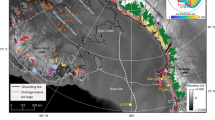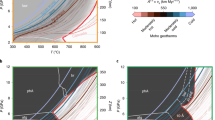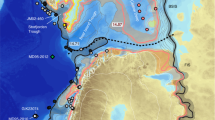Abstract
The record of sea-level change at Barbados derived from the dating of fossil corals1,2,3 has been used to argue that globally averaged, or eustatic, sea level during the Last Glacial Maximum was approximately 120 m below present3. This estimate is roughly 10 m lower than inferences based on sea-level data from other far-field sites4 and, if correct, would suggest that the Barbados record is a largely uncontaminated measure of eustasy3. However, these previous analyses1,2,3,4 were based on numerical corrections for glacial isostatic adjustment that adopted one-dimensional viscoelastic Earth models. Here we assess the impact of three-dimensional mantle viscoelastic structure on predictions of post-glacial sea-level change at Barbados. Our simulations indicate that the predictions are strongly perturbed by the presence of a high-viscosity slab associated with subduction of the South American Plate beneath the Caribbean Plate. The slab suppresses local deformation and reduces the sea-level rise predicted during the deglaciation phase. To accommodate this reduction while maintaining a fit to the Barbados sea-level record requires an excess ice volume at the Last Glacial Maximum equivalent to about 130 m of eustatic sea-level rise. Given a downward revision in estimates of the Antarctic ice sheet contribution5 to this excess ice volume, we conclude that a significant amount of Northern Hemisphere ice at the Last Glacial Maximum remains unaccounted for in sea-level-based ice sheetreconstructions.
This is a preview of subscription content, access via your institution
Access options
Subscribe to this journal
Receive 12 print issues and online access
$259.00 per year
only $21.58 per issue
Buy this article
- Purchase on Springer Link
- Instant access to full article PDF
Prices may be subject to local taxes which are calculated during checkout




Similar content being viewed by others
References
Fairbanks, R. G. A 17,000-year glacio-eustatic sea level record: Influence of glacial melting rates on the Younger Dryas event and deep-ocean circulation. Nature 342, 637–642 (1989).
Bard, E., Hamelin, B. & Fairbanks, R. G. U–Th ages obtained by mass spectrometry in corals from Barbados: Sea level during the past 130,000 years. Nature 346, 456–458 (1990).
Peltier, W. R. & Fairbanks, R. G. Global glacial ice volume and Last Glacial Maximum duration from an extended Barbados sea level record. Quat. Sci. Rev. 25, 3322–3337 (2006).
Yokoyama, Y., Lambeck, K., De Deckker, P., Johnston, P. & Fifield, L. K. Timing of the Last Glacial Maximum from observed sea-level minima. Nature 406, 713–716 (2000).
Whitehouse, P. L., Bentley, M. J. & Le Brocq, A. M. A deglacial model of Antarctica: Geological constraints and glaciological modeling as a basis for a new model of Antarctic glacial isostatic adjustment. Quat. Sci. Rev. 32, 1–24 (2012).
Pinot, S. et al. Tropical paleoclimates at the Last Glacial Maximum: Comparison of Paleoclimate Modeling Intercomparison Project (PMIP) simulations and paleodata. Clim. Dynam. 15, 857–874 (1999).
Lambeck, K., Yokoyama, Y. & Purcell, T. Into and out of the Last Glacial Maximum: Sea level change during oxygen isotope stages 3 and 2. Quat. Sci. Rev. 22, 343–360 (2002).
Chappell, J. & Shackleton, N. J. Oxygen isotopes and sea level. Nature 324, 137–140 (1986).
Waelbroeck, C. et al. Sea-level and deep water temperature changes derived from benthic foraminifera isotopic records. Quat. Sci. Rev. 21, 295–305 (2002).
Mix, A. & Ruddiman, W. F. Oxygen isotope analyses and Pleistocene ice volumes. Quat. Res. 21, 1–20 (1984).
Pindell, J., Cande, S., Pitman, W. C., Rowley, K. C. & Dewey, J. F. A plate-kinematic framework for models of Caribbean evolution. Tectonophysics 155, 121–138 (1988).
Clark, P. U. et al. The last glacial maximum. Science 32, 710–714 (2009).
Peltier, W. R. Global glacial isostasy and the surface of the ice-age Earth: The ICE-5G (VM2) model and GRACE. Annu. Rev. Earth Planet. Sci. 32, 111–149 (2004).
Engelhart, S. E., Peltier, W. R. & Horton, B. P. Holocene relative sea-level changes and glacial isostatic adjustment of the US Atlantic coast. Geology 39, 751–754 (2009).
Milne, G. & Mitrovica, J. X. Searching for eustasy in deglacial sea-level histories. Quat. Sci. Rev. 2, 2292–2302 (2008).
Kendall, R., Mitrovica, J. X. & Milne, G. A. On post-glacial sea level: II. Numerical formulation and comparative results on spherically symmetric models. Geophys. J. Int. 161, 679–706 (2005).
Nakada, M. & Lambeck, K. Late Pleistocene and Holocene sea-level change in the Australian region and mantle rheology. Geophys. J. Int. 96, 497–517 (1989).
Mitrovica, J. X. & Milne, G. A. On the origin of late Holocene sea-level highstands within equatorial ocean basins. Quat. Sci. Rev. 21, 2179–2190 (2002).
Miller, M. S. & Becker, T. W. Mantle flow deflected by interactions between subducted slabs and cratonic keels. Nature Geosci. 5, 726–730 (2012).
Latychev, K., Mitrovica, J. X., Tromp, J., Tamisiea, M. E., Komatitsch, D. & Christara, C. Glacial isostatic adjustment on 3D Earth models: A finite-volume formulation. Geophys. J. Int. 161, 421–444 (2005).
Conrad, C. P. & Lithgow-Bertelloni, C. Influence of continental roots and asthenosphere on plate-mantle coupling. Geophys. Res. Lett. 33, L05312 (2006).
Bird, P. An updated digital model of plate boundaries. Geochem. Geophys. Geosys. 4, Q1027 (2003).
Ritsema, J., Deuss, A., van Heijst, H. J. & Woodhouse, J. H. S40RTS: A degree-40 shear-velocity model for the mantle from new Rayleigh wave dispersion, teleseismic traveltime and normal-mode splitting function measurements. Geophys. J. Int. 184, 1223–1236 (2011).
Gudmundsson, O. & Sambridge, M. A regionalized upper mantle (RUM) seismic model. J. Geophys. Res. 10, 7121–7136 (1998).
Billen, M.I. Modeling the dynamics of subducting slabs. Annu. Rev. Earth Planet. Sci. 36, 325–356 (2008).
Watts, A.B. Isostasy and Flexure of the Lithosphere (Cambridge Univ. Press, 2001).
Scholz, C.H. The Mechanics of Earthquakes and Faulting (Cambridge Univ. Press, 2002).
Yokoyama, Y. et al. Holocene sea-level change and Antarctic melting history derived from geological observations and geophysical modeling along the Shimokita Peninsula, northern Japan. Geophys. Res. Lett. 39, L13502 (2012).
Ivins, E.R. & Sammis, C.G. On lateral viscosity contrast in the mantle and the rheology of low-frequency geodynamics. Geophys. J. Int. 123, 305–322 (1995).
Kaufmann, G., Wu, P. & Ivins, E.R. Lateral viscosity variations beneath Antarctica and their implications on regional rebound motions and seismotectonics. J. Geodynam. 39, 165–181 (2005).
Acknowledgements
Support for this research was provided by NSF-OCE-1202632, Harvard University and the Canadian Institute for Advanced Research.
Author information
Authors and Affiliations
Contributions
All authors contributed extensively to the research presented in this paper. J.A. and J.X.M. co-wrote the manuscript.
Corresponding author
Ethics declarations
Competing interests
The authors declare no competing financial interests.
Supplementary information
Supplementary Information
Supplementary Information (PDF 650 kb)
Rights and permissions
About this article
Cite this article
Austermann, J., Mitrovica, J., Latychev, K. et al. Barbados-based estimate of ice volume at Last Glacial Maximum affected by subducted plate. Nature Geosci 6, 553–557 (2013). https://doi.org/10.1038/ngeo1859
Received:
Accepted:
Published:
Issue Date:
DOI: https://doi.org/10.1038/ngeo1859
This article is cited by
-
Submerged reef features in Apo and Tubbataha Reefs, Philippines, revealed paleo sea-level history during the last deglaciation
Geo-Marine Letters (2024)
-
Influence of reef isostasy, dynamic topography, and glacial isostatic adjustment on sea-level records in Northeastern Australia
Communications Earth & Environment (2023)
-
Benthic δ18O records Earth’s energy imbalance
Nature Geoscience (2023)
-
Reply to: Towards solving the missing ice problem and the importance of rigorous model data comparisons
Nature Communications (2022)
-
A reconciled solution of Meltwater Pulse 1A sources using sea-level fingerprinting
Nature Communications (2021)



